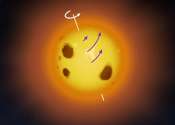Gaia creates richest star map of our Galaxy—and beyond
ESA's Gaia mission has produced the richest star catalogue to date, including high-precision measurements of nearly 1.7 billion stars and revealing previously unseen details of our home Galaxy.

ESA's Gaia mission has produced the richest star catalogue to date, including high-precision measurements of nearly 1.7 billion stars and revealing previously unseen details of our home Galaxy.
Astronomy
Apr 25, 2018
0
1793

(Phys.org)—Astronomers report the detection of new eruptions in two luminous blue variables, known as R 40 and R 110, located in the Magellanic Clouds. The finding, presented December 5 in a paper published on the arXiv ...

Astronomers using the MUSE instrument on ESO's Very Large Telescope in Chile have conducted the deepest spectroscopic survey ever. They focused on the Hubble Ultra Deep Field, measuring distances and properties of 1600 very ...
Astronomy
Nov 29, 2017
0
200

A team working with ESO's High Accuracy Radial velocity Planet Searcher (HARPS) at the La Silla Observatory in Chile has found that the red dwarf star Ross 128 is orbited by a low-mass exoplanet every 9.9 days. This Earth-sized ...
Astronomy
Nov 15, 2017
36
880

(Phys.org)—An international team of astronomers has discovered a Jupiter-mass alien world circling a giant star known as HD 208897. The newly detected exoplanet was found as a result of high-precision radial velocity measurements. ...

ESA's star-surveying Gaia mission has again proven to be a formidable asteroid explorer, spotting potential moons around more than 350 asteroids not known to have a companion.
Astronomy
Aug 8, 2024
0
171

A surprising discovery about the evolution of our galaxy using data from the Gaia mission found a large number of ancient stars on orbits similar to that of our sun. They formed the Milky Way's thin disk less than 1 billion ...
Astronomy
Jul 31, 2024
4
202

Our solar system is our immediate cosmic neighborhood. We know it well: the sun at the center; then the rocky planets Mercury, Venus, Earth, and Mars; and then the asteroid belt; followed by the gas giants Jupiter and Saturn; ...
Planetary Sciences
Jul 31, 2024
0
45

The sun rotates the fastest at the equator, whereas the rotation rate slows down at higher latitudes and is the slowest at the polar regions. But a nearby sun-like star—V889 Herculis, some 115 light years away in the constellation ...
Astronomy
Jul 31, 2024
0
159

Towards the center of our Milky Way galaxy, in the constellation Sagittarius, astronomers have discovered 10 monstrous neutron stars. These particular stars, called pulsars, reside together in globular cluster Terzan 5, a ...
Astronomy
Jul 16, 2024
11
249